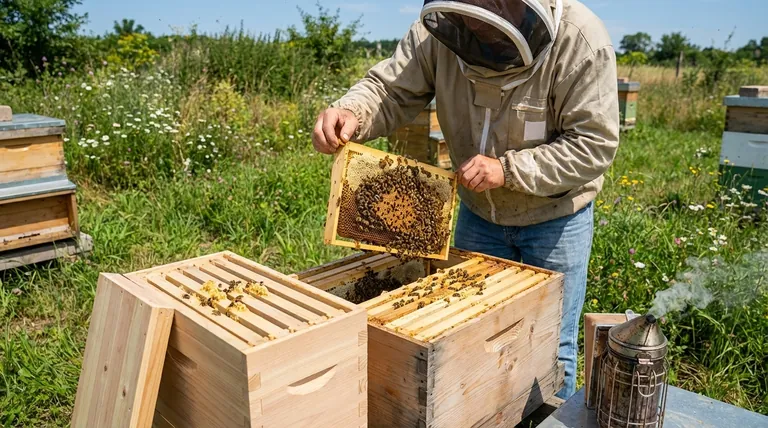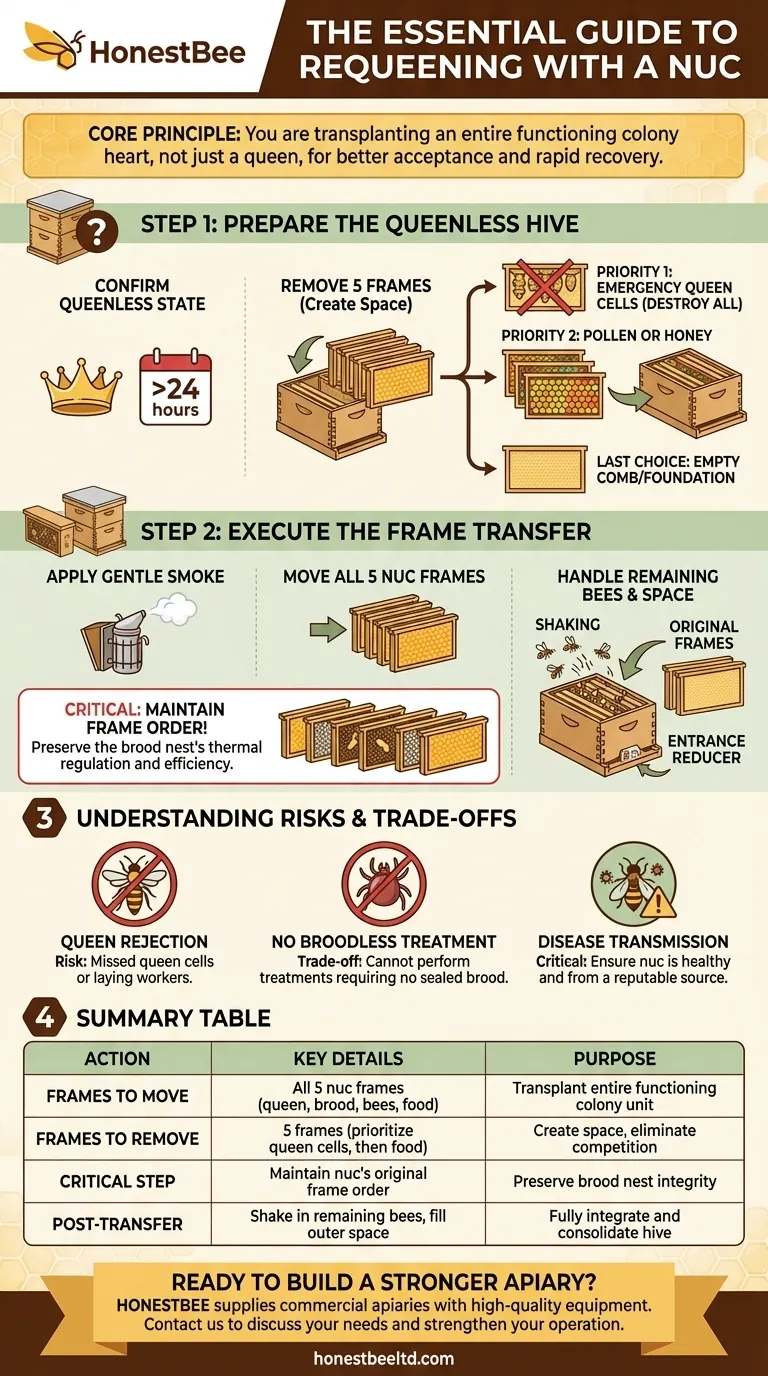When requeening a hive with a nucleus colony, your objective is to move the entire nuc — all five of its frames — into the queenless hive. This transfer includes the nuc's queen, brood, bees, and food stores. To make room, you will first remove five frames from the queenless hive, strategically choosing frames that will ensure the new queen is accepted.
The core principle is not just to replace a queen, but to transplant an entire functioning colony heart. You are moving the nuc's established brood nest as a single, undisturbed unit to give the queenless hive the best possible chance of acceptance and rapid recovery.

Preparing the Queenless Hive for Acceptance
Before introducing the new frames, you must prepare the recipient hive. This preparation is the most critical factor in determining whether the colony will accept or reject the new queen and her bees.
Step 1: Confirm the Hive is Queenless
The recipient colony must be definitively queenless. The absence of a queen, eggs, and young larvae for at least 24 hours ensures the hive's pheromone profile signals a need for a new queen, making them receptive.
Step 2: Remove Five Frames from the Hive
You must remove five frames from the center of the brood box to create space for the nuc. The frames you choose to remove are just as important as the ones you add.
Your primary target for removal should be any frames containing emergency queen cells. If you leave even one queen cell, the colony will likely follow its own instinct to raise that queen and kill the one you are introducing.
After removing frames with queen cells, prioritize removing frames of pollen or honey. While this seems counterintuitive, the nuc will bring its own immediate food supply. Removing a food frame from the host hive and placing it at the outer edge of the box can consolidate resources. Frames of empty drawn comb or foundation are the last choice for removal.
Executing the Frame Transfer
The physical transfer should be done calmly and deliberately to minimize stress on the bees and maintain the integrity of the nuc's brood nest.
The Importance of Maintaining Frame Order
The frames in a nucleus colony are a carefully arranged system. The queen lays eggs in the center, surrounded by progressively older brood, which is in turn surrounded by pollen and honey.
Maintain this exact order when you move the frames from the nuc box to the main hive. Placing them in the same configuration preserves the thermal regulation and efficiency of the brood nest, preventing a setback for the colony.
The Transfer Process
Use a smoker to apply a few gentle puffs of cool, white smoke to the entrances of both the hive and the nuc to calm the bees.
One by one, lift each frame from the nuc box and place it into the empty space you created in the hive, keeping the frames together in their original order. The nuc frames should be placed as a single block in the center of the brood box.
Handling the Remaining Bees and Space
After moving all five frames, there will be bees left in the nuc box. Gently shake or bump these bees into the main hive on top of the newly installed frames.
Fill the remaining empty slots on either side of the nuc frames with the frames you kept from the original hive. It's best to place food frames on the outside. Finally, add an entrance reducer to the hive to help the newly combined colony defend itself.
Understanding the Risks and Trade-offs
While this method is highly reliable, it is not without risks. Understanding them helps you mitigate potential failures.
The Risk of Queen Rejection
The primary risk is a failure to remove all queen cells from the recipient hive. A missed queen cell is the most common reason a colony will reject a new nuc. In rare cases, a hidden virgin queen or a hive that has developed laying workers can also cause rejection.
No Opportunity for a Broodless Mite Treatment
Installing a nuc is a way to requeen without a "brood break"—a period where the hive has no sealed brood. While this promotes faster population growth, it also means you cannot perform certain highly effective Varroa mite treatments (like oxalic acid vaporization) that require a broodless period.
Potential for Disease Transmission
You are combining two colonies. It is critical that the nucleus colony you are introducing is healthy and free from diseases like American or European Foulbrood. Always source nucs from a reputable and trusted beekeeper.
Making the Right Choice for Your Goal
Your specific actions should align with your primary objective for the colony.
- If your primary focus is rapid population growth: Installing a queen-right nuc is the single fastest way to boost a weak or struggling hive, as you are adding a proven laying queen and five frames of brood and bees.
- If your primary concern is queen acceptance: Your most critical task is to meticulously search every frame you leave in the recipient hive and destroy every single queen cell.
- If you are managing a hive you just made queenless: Wait at least 24 hours, and up to 48, before installing the nuc to ensure the colony's bees have fully recognized their queenless state.
By carefully preparing the hive and respecting the integrity of the nucleus colony, you ensure a seamless transition that sets your hive on a path to strength and productivity.
Summary Table:
| Action | Key Details | Purpose |
|---|---|---|
| Frames to Move | All 5 frames from the nuc, including the queen, brood, bees, and food. | Transplant the entire functioning colony unit. |
| Frames to Remove | 5 frames from the queenless hive, prioritizing those with queen cells, then pollen/honey. | Create space and eliminate competition for the new queen. |
| Critical Step | Maintain the nuc's original frame order (brood nest in the center) when transferring. | Preserve brood nest integrity for thermal regulation and colony stability. |
| Post-Transfer | Shake remaining bees from nuc box into the hive; fill outer spaces with original frames. | Fully integrate the two bee populations and consolidate the hive. |
Ready to build a stronger, more productive apiary? A successful requeening starts with reliable equipment. HONESTBEE supplies commercial apiaries and beekeeping equipment distributors with the high-quality, durable supplies needed for smooth hive management. From nuc boxes to full hive setups, our wholesale-focused operations ensure you get the gear that supports your success. Contact HONESTBEE today to discuss your equipment needs and strengthen your beekeeping operation.
Visual Guide

Related Products
- 5 Frame Wooden Nuc Box for Beekeeping
- 5 Frame Langstroth Poly Nuc Corrugated Plastic Nuc Boxes
- HONESTBEE Professional Long Handled Hive Tool with Precision Cutting Blade
- Honey Flow Garden Bee Hive Flow Hive Best Beehive for Beginners
- Portable Bee Mating Hive Boxes Mini Mating Nucs 8 Frames for Queen Rearing
People Also Ask
- What is a common feature of many 5-frame nuc boxes? The Integrated Feeder for Efficient Colony Growth
- How should the nuc be installed in the apiary? Ensure Colony Success from Day One
- What is the advantage of overwintering a nucleus? A Strategic Asset for Beekeeping Success
- What is the purpose of having a nuc in beekeeping? Build a Resilient & Productive Apiary
- What is the most common type of standard nuc? The 5-Frame Nuc Explained



















